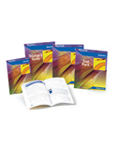Geometry and the other "Power Basics" courses are written for students in grades 6 through 12. These courses try to cover the basic content students need to master but in a simplified fashion. Geometry is a really a high school level course since it requires at least pre-algebra level math knowledge. Reading level for "Power Basics" is about fourth-fifth grade. Student worktexts are 6" x 9" with relatively large print so there is significantly less content per page than in standard textbooks. These courses might be used for remedial work, for students with learning difficulties, or as brief overview courses for students who simply haven't studied the subject matter.
The five components you need for each course are a student book, student book teacher's guide, workbook, workbook answer key, and test pack. (The publisher sells these five items as a "single pack.") The student book is a consumable worktext; students write some responses directly in the book although the bulk of their written work is done in the workbook. Student workbooks are 8.5" x 11". Although their font size is smaller than the student text, they still have reasonably large spaces for written responses and do not appear overwhelming.
Even though the student book teacher's guide has some instructional information, the courses are really set up so that students can work independently for the most part with parents/teachers correcting work and administering tests. The teacher's guide serves as the answer key to the student text. The test pack includes its own answer key. There is a separate key for the workbook. The "single pack" with all five items is sold by the publisher for $59.99.
Geometry is divided into for sections: lines and angles, perimeter/circumference/area, volume, and coordinate geometry. The text is written directly to the student with thorough explanation, examples, and real life applications. Some practice problems are in the text, but most exercises for each topic are in the workbook.
The amount of instruction is necessarily limited in this 241-page book. It doesn't go into very complex or unusual examples. For example, there are few of those geometric diagrams where students have to determine the size of many different angles when they are given only a few "clues." Also, students learn nothing about chords and tangents beyond their definitions.
This course would satisfy the requirement for a high school level course but would not be adequate for a college prep student who will be moving directly on to advanced math or Algebra 2.









